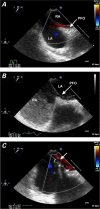Potential Role of Patent Foramen Ovale in Exacerbating Hypoxemia in Chronic Pulmonary Disease
- PMID: 28761399
- PMCID: PMC5505397
- DOI: 10.14503/THIJ-16-6027
Potential Role of Patent Foramen Ovale in Exacerbating Hypoxemia in Chronic Pulmonary Disease
Abstract
Patent foramen ovale has been associated with multiple pulmonary diseases, such as pulmonary hypertension, platypnea-orthodeoxia syndrome, and chronic obstructive pulmonary disease. A connection between patent foramen ovale and chronic pulmonary disease was first described more than 2 decades ago in case reports associating patent foramen ovale with more severe hypoxemia than that expected based on the severity of the primary pulmonary disease. It has been suggested that patients with both chronic pulmonary disease and patent foramen ovale are subject to severe hypoxemia because of the right-to-left shunt. Furthermore, investigators have reported improved systemic oxygenation after patent foramen ovale closure in some patients with chronic pulmonary disease. This review focuses on the association between chronic pulmonary disease and patent foramen ovale and on the dynamics of a right-to-left shunt, and it considers the potential benefit of patent foramen ovale closure in patients who have hypoxemia that is excessive in relation to the degree of their pulmonary disease.
Keywords: Diagnostic imaging; exercise tolerance; foramen ovale, patent/complications/diagnosis/diagnostic imaging/physiopathology/surgery/therapy; heart septal defects, atrial/prevention & control; hemodynamics; hypertension, pulmonary/complications/etiology/physiopathology; hypoxia/complications/diagnosis/etiology; pulmonary disease, chronic obstructive/complications/physiopathology/therapy; recovery of function; risk factors.
Figures




References
-
- Smith B, . editor Large animal internal medicine. St. Louis: Mosby; 2002. p 452.
-
- Beard RW. Fetal physiology and medicine: the basis of perinatology (reproductive medicine). New York: Marcel Dekker Inc.; 1984. p 300.
-
- Nootens MT, Berarducci LA, Kaufmann E, Devries S, Rich S.. The prevalence and significance of a patent foramen ovale in pulmonary hypertension. Chest 1993; 104 6: 1673– 5. - PubMed
-
- Sardesai SH, Marshall RJ, Mourant AJ.. Paradoxical systemic embolisation through a patent foramen ovale. Lancet 1989; 1 8640: 732– 3. - PubMed
-
- Movsowitz C, Podolsky LA, Meyerowitz CB, Jacobs LE, Kotler MN.. Patent foramen ovale: a nonfunctional embryological remnant or a potential cause of significant pathology? J Am Soc Echocardiogr 1992; 5 3: 259– 70. - PubMed
Publication types
MeSH terms
LinkOut - more resources
Full Text Sources
Other Literature Sources
Medical

